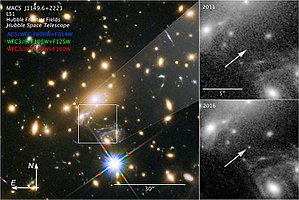 Detection of MACS J1149 Lensed Star 1 A galactic cluster (left) magnified a distant star (now named Icarus) more than 2,000 times, making it visible in 2016 from Earth (lower right), 9.34 billion light-years away—although visible in 2016, the star was not visible in 2011 (upper right). | |
| Observation data Epoch J2000[1] Equinox J2000[1] | |
|---|---|
| Constellation | Leo[1][2] |
| Right ascension | 11h 49m 35.59s[1] |
| Declination | 22° 23′ 47.4″[1] |
| Astrometry | |
| Distance | Redshift of 1.49 yields comoving distances of 14.4 billion ly |
| Characteristics | |
| Spectral type | B[2] |
| Apparent magnitude (V) | ≈28.4[2] (normally 29.9)[note 1] |
| Apparent magnitude (R) | ≈28.2[2] (normally 29.7) |
| Apparent magnitude (Z) | ≈27.9[2] (normally 29.4) |
| Apparent magnitude (J) | 27.3[2] (normally 28.8) |
| Apparent magnitude (H) | 27.4[2] (normally 28.9) |
| Details | |
| Surface gravity (log g) | 2 - 4[2] cgs |
| Temperature | 11,000 – 14,000[2] K |
| Metallicity | ≈0.006[2] |
| Age | ~8[2] Myr |
| Other designations | |
Icarus, LS1, MACS J1149 LS1, MACS J1149 Lensed Star 1 (LS1), MACS J1149+2223 Lensed Star 1 | |
MACS J1149 Lensed Star 1, also known as Icarus,[note 2] is a blue supergiant star observed through a gravitational lens. It is the seventh most distant individual star to have been detected so far (after Earendel, Godzilla, Mothra, Quyllur, star-1 and star-2), at approximately 14 billion light-years from Earth (redshift z=1.49; comoving distance of 14.4 billion light-years; lookback time of 9.34 billion years).[3][2][4][5][6][7][8] Light from the star was emitted 4.4 billion years after the Big Bang.[7] According to co-discoverer Patrick Kelly, the star is at least a hundred times more distant than the next-farthest non-supernova star observed, SDSS J1229+1122, and is the first magnified individual star seen.[4][7]
- ^ a b c d Kelly, P. L. (2015). "Multiple images of a highly magnified supernova formed by an early-type cluster galaxy lens". Science. 347 (6226): 1123–1126. arXiv:1411.6009. Bibcode:2015Sci...347.1123K. doi:10.1126/science.aaa3350. PMID 25745167. S2CID 206633888.
- ^ a b c d e f g h i j k l Kelly, Patrick L.; et al. (2 April 2018). "Extreme magnification of an individual star at redshift 1.5 by a galaxy-cluster lens". Nature Astronomy. 2 (4): 334–342. arXiv:1706.10279. Bibcode:2018NatAs...2..334K. doi:10.1038/s41550-018-0430-3. S2CID 125826925.
- ^ Staff (2018). "Cosmological information and results: redshift z=1.49". Wolfram Alpha. Retrieved 4 April 2018.
- ^ a b Jenkins, Ann; Villard, Ray; Kelly, Patrick (2 April 2018). "Hubble Uncovers the Farthest Star Ever Seen". NASA. Retrieved 2 April 2018.
- ^ Howell, Elizabeth (2 April 2018). "Rare Cosmic Alignment Reveals Most Distant Star Ever Seen". Space.com. Retrieved 2 April 2018.
- ^ Sanders, Robert (2 April 2018). "Hubble peers through cosmic lens to capture most distant star ever seen". Berkeley News. Retrieved 2 April 2018.
- ^ a b c Parks, Jake (2 April 2018). "Hubble spots farthest star ever seen". Astronomy. Retrieved 2 April 2018.
- ^ Cite error: The named reference
RTRS-20180402was invoked but never defined (see the help page).
Cite error: There are <ref group=note> tags on this page, but the references will not show without a {{reflist|group=note}} template (see the help page).